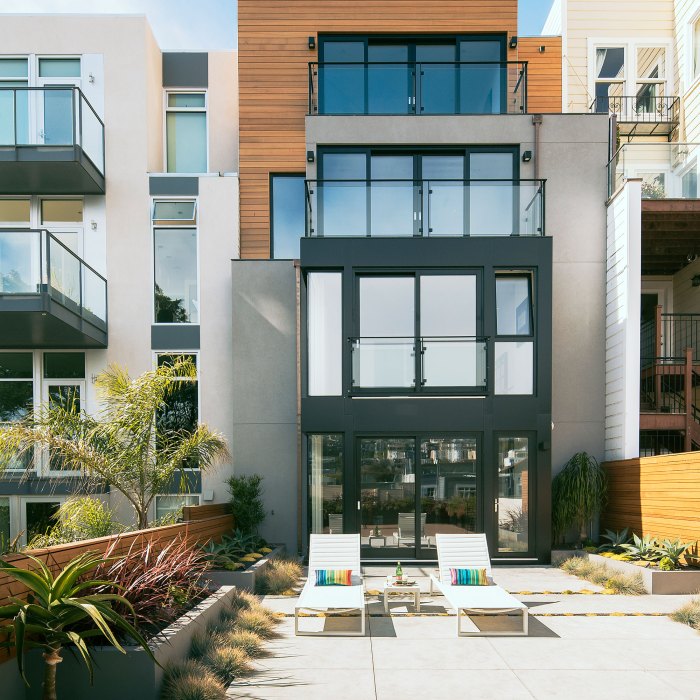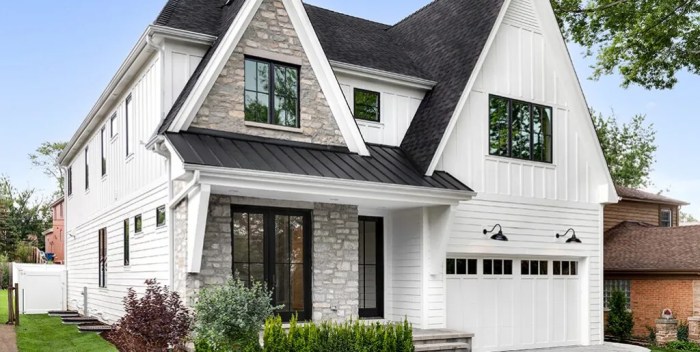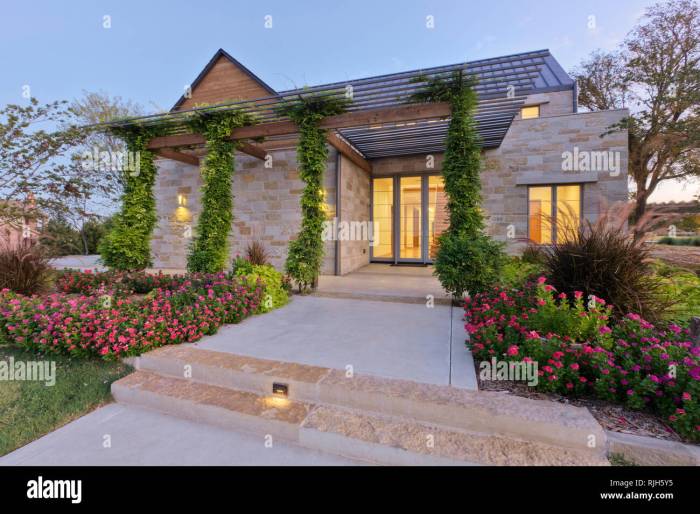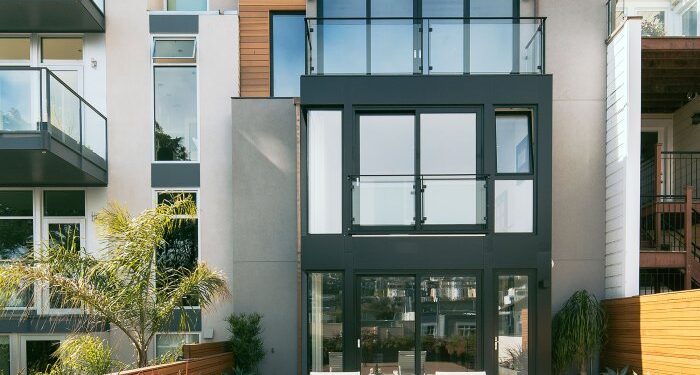As energy efficient home exteriors take the spotlight, this introductory passage invites readers to explore a world of knowledge, promising an engaging and informative journey ahead.
In the following paragraphs, we delve into the significance of energy-efficient home exteriors and how they can positively impact both your finances and the environment.
Importance of Energy-Efficient Home Exteriors

Energy-efficient home exteriors play a crucial role in reducing energy consumption, lowering utility bills, and minimizing environmental impact. By incorporating the right materials and technologies, homeowners can greatly improve the energy efficiency of their homes.
Benefits of Energy-Efficient Home Exteriors
- Improved Insulation: High-quality insulation materials such as spray foam, cellulose, or fiberglass help maintain a consistent indoor temperature, reducing the need for heating or cooling.
- Energy-Efficient Windows: Double or triple-pane windows with low-E coatings prevent heat transfer, keeping the home cooler in summer and warmer in winter.
- Solar Panels: Installing solar panels on the exterior can harness renewable energy, further reducing reliance on traditional power sources.
Reduced Utility Bills and Environmental Impact
Energy-efficient home exteriors result in lower energy consumption, leading to significant savings on utility bills over time. By reducing the demand for heating and cooling, homeowners can also decrease their carbon footprint and contribute to a more sustainable environment.
Design Elements for Energy Efficiency
Proper design elements play a crucial role in ensuring that a home is energy-efficient. From insulation to windows, doors, roofing, air sealing, and weatherization, each component contributes to maintaining a comfortable indoor environment while minimizing energy consumption.
Insulation
Insulation is a key component of energy-efficient home exteriors. Proper insulation helps regulate the temperature inside the home by preventing heat loss during colder months and heat gain during warmer months. This reduces the need for heating and cooling, ultimately leading to lower energy bills.
Windows, Doors, and Roofing
Windows, doors, and roofing also play a significant role in maintaining energy efficiency. Energy-efficient windows and doors with proper seals help prevent drafts, while reflective roofing materials can reduce heat absorption and lower cooling costs. Choosing high-quality materials and ensuring proper installation are essential for maximizing energy savings.
Air Sealing and Weatherization
Air sealing and weatherization are important aspects of energy-efficient home exteriors. Properly sealing gaps and cracks in walls, windows, doors, and other openings helps prevent air leakage, reducing the workload on heating and cooling systems. Weatherization techniques such as adding weatherstripping and caulking can further improve energy efficiency by creating a tighter thermal envelope.
Sustainable Materials and Construction Techniques
When it comes to creating energy-efficient home exteriors, using sustainable materials and construction techniques plays a crucial role in reducing environmental impact and improving overall efficiency.
Sustainable Materials
- Bamboo: Known for its rapid growth and renewability, bamboo is a popular choice for siding and decking materials in energy-efficient homes.
- Recycled Steel: Utilizing recycled steel for roofing not only reduces waste but also provides durability and energy efficiency.
- Cellulose Insulation: Made from recycled paper products, cellulose insulation is an eco-friendly option that enhances energy efficiency by reducing heat transfer.
Construction Techniques for Energy Efficiency
- Proper Insulation: Ensuring proper insulation throughout the exterior walls and roof helps maintain a consistent indoor temperature, reducing the need for heating and cooling.
- Air Sealing: Sealing any gaps or cracks in the building envelope prevents air leakage, improving energy efficiency and indoor air quality.
- High-performance Windows: Installing energy-efficient windows with low-E coatings and double or triple pane glass minimizes heat loss and solar heat gain.
Lifespan and Maintenance Considerations
Using sustainable materials in energy-efficient home exteriors not only benefits the environment but also offers long-term durability. Bamboo, for example, has a lifespan comparable to hardwoods when properly maintained. Recycled steel roofing can last 50+ years with minimal maintenance. Cellulose insulation is known for its longevity and requires little upkeep over time, making it a cost-effective and sustainable choice for energy-efficient homes.
Landscaping and Exterior Features

Landscaping and exterior features play a crucial role in enhancing the energy efficiency of a home. By strategically planning and incorporating eco-friendly practices, homeowners can reduce energy consumption and create a sustainable living environment.
Landscaping for Energy Efficiency
- Planting trees strategically around the house can provide natural shading during hot summer months, reducing the need for excessive air conditioning.
- Grass and vegetation can act as natural insulation, helping to regulate the temperature inside the home and reduce the workload on heating and cooling systems.
- Choosing native plants and drought-resistant landscaping can minimize water usage and maintenance costs while promoting biodiversity.
Impact of Exterior Features
- Overhangs and awnings can help block direct sunlight in the summer, reducing heat gain and lowering cooling costs.
- Proper orientation of windows and doors can maximize natural light and ventilation, reducing the need for artificial lighting and HVAC systems.
- Shading elements like pergolas, trellises, and outdoor blinds can further enhance energy efficiency by providing additional insulation and reducing solar heat gain.
Eco-Friendly Practices
- Installing a rain garden or permeable paving can help manage stormwater runoff and reduce water pollution, promoting sustainability.
- Using recycled materials for hardscaping and outdoor furniture not only reduces waste but also minimizes the environmental impact of construction.
- Implementing a drip irrigation system or rainwater harvesting can help conserve water resources and support a more sustainable landscape design.
Closure

In conclusion, embracing energy-efficient home exteriors is not just a trend but a smart choice for a sustainable future. With the right materials and design elements, you can create a home that is both eco-friendly and cost-effective.
Frequently Asked Questions
How can energy-efficient home exteriors reduce utility bills?
Energy-efficient exteriors help in maintaining optimal indoor temperature, reducing the need for excessive heating or cooling, which in turn lowers energy consumption and utility bills.
What are some common sustainable materials used in energy-efficient home exteriors?
Materials like recycled wood, bamboo, and insulated concrete are commonly used for their eco-friendly properties and energy efficiency.
How does landscaping impact the energy efficiency of a home?
Strategic placement of trees and bushes can provide natural shading, reducing the need for air conditioning during hot seasons and contributing to overall energy savings.









